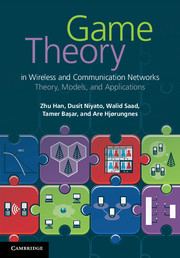Book contents
- Frontmatter
- Contents
- Preface
- 1 Introduction
- 2 Wireless networks: an introduction
- Part I Fundamentals of game theory
- Part II Applications of game theory in communications and networking
- 9 Cellular and broadband wireless access networks
- 10 Wireless local area networks
- 11 Multi-hop networks
- 12 Cooperative-transmission networks
- 13 Cognitive-radio networks
- 14 Internet networks
- References
- Index
10 - Wireless local area networks
from Part II - Applications of game theory in communications and networking
Published online by Cambridge University Press: 25 October 2011
- Frontmatter
- Contents
- Preface
- 1 Introduction
- 2 Wireless networks: an introduction
- Part I Fundamentals of game theory
- Part II Applications of game theory in communications and networking
- 9 Cellular and broadband wireless access networks
- 10 Wireless local area networks
- 11 Multi-hop networks
- 12 Cooperative-transmission networks
- 13 Cognitive-radio networks
- 14 Internet networks
- References
- Index
Summary
IEEE 802.11 wireless local area networks (WLANs) have been widely deployed in many places for both residential and commercial use. The IEEE 802.11 standard supports two major configurations – i.e., the point – coordination function (PCF) and the distributed coordination function (DCF). With PCF, the transmission in the network is based on a central node (i.e., an access point). Client nodes listen to the channel and wait for the signal from the access point. Once permission is sent by the access point, the client node can start data transmission. On the other hand, with DCF, the nodes employ carrier-sense multiple-access with collision avoidance (CSMA/CA) for MAC protocol. Each node can transmit independently, based on the availability of the channel. In particular, with CSMA/CA, the nodes listen for the channel status. If the channel is busy, the node defers its transmission by waiting for a backoff period. If a node senses a channel is idle, it will wait for a certain period of time and start transmission. In this case, multiple nodes can start transmissions at the same time, which results in collision. The colliding nodes will wait for the backoff period, and then sense for transmission again. To avoid performance degradation arising from packet collision, the backoff period can be adjusted, according to a specific rule, on the basis of the congestion level in the network (e.g., the rate of packet collisions).
- Type
- Chapter
- Information
- Game Theory in Wireless and Communication NetworksTheory, Models, and Applications, pp. 321 - 344Publisher: Cambridge University PressPrint publication year: 2011
- 2
- Cited by



